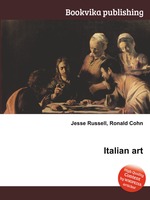Italian art
Jesse Russell Ronald Cohn
бумажная книга
High Quality Content by WIKIPEDIA articles! The history of Italian art is in many ways also the history of Western art. After Etruscan civilization and especially the Roman Republic and Empire that dominated this part of the world for many centuries, Italy was central to European art during the Renaissance. Italy also saw European artistic dominance in the 16th and 17th centuries with the Baroque artistic movement. Nonetheless, by the 18th century, the country saw a decline in its artistic output and it started to lose its lustre as Europe and the Western world`s artistic leader, with France reaching its artistic zenith through movements such as the Rococo and Neoclassicism. Nonetheless, it re-established a strong presence in the international art scene from the mid-19th century onwards, with movements such as the Macchiaioli, Futurism, Metaphysical, Novecento Italiano, Spatialism, Arte Povera and Transavantgarde. Italian art has influenced several major movements throughout the centuries and has produced several great artists, including painters and sculptors. Today, Italy has an important place in the international art scene, with several major art galleries, museums and exhibitions; major artistic centres in the country include its capital city, Rome, Florence, Venice, Milan, Naples, Turin, and other cities.


